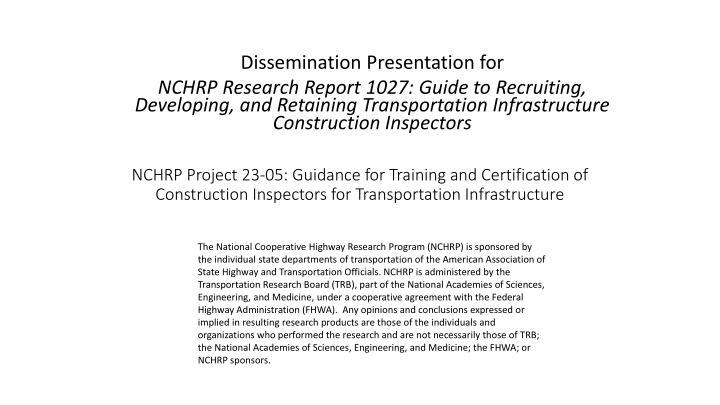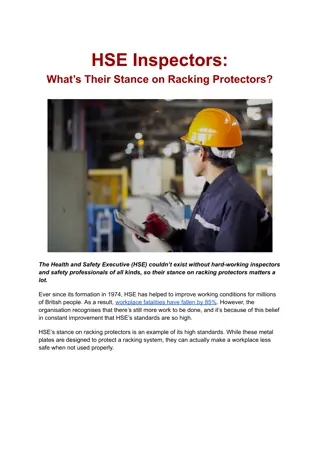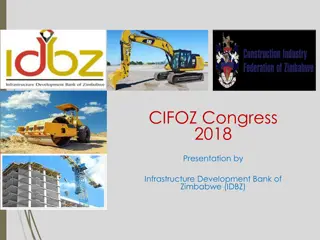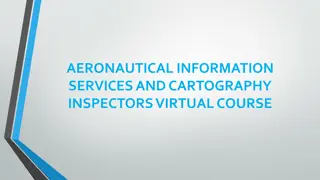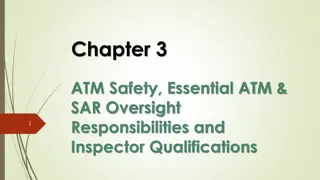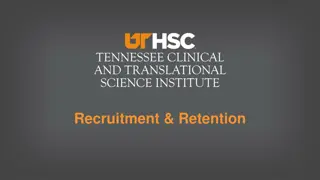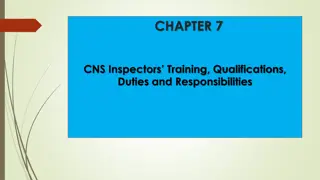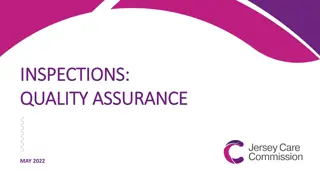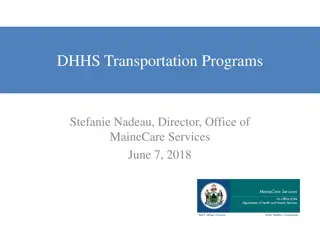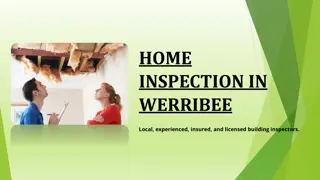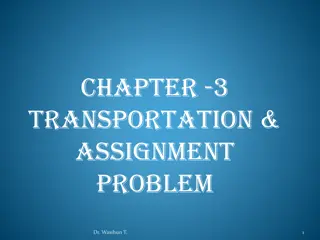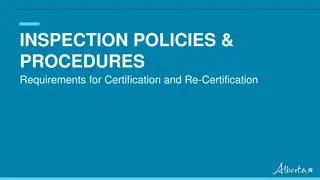Guide to Transportation Infrastructure Inspectors Recruitment & Training
This project delves into the essential areas of recruiting, developing, and retaining inspectors for transportation infrastructure projects. It aims to identify competency gaps, develop training strategies, create transferable certification programs, and enhance professional development opportunities for construction inspectors. The research also focuses on utilizing technologies for efficient inspections and formulating recruitment and retention strategies.
Uploaded on Mar 16, 2025 | 1 Views
Download Presentation

Please find below an Image/Link to download the presentation.
The content on the website is provided AS IS for your information and personal use only. It may not be sold, licensed, or shared on other websites without obtaining consent from the author.If you encounter any issues during the download, it is possible that the publisher has removed the file from their server.
You are allowed to download the files provided on this website for personal or commercial use, subject to the condition that they are used lawfully. All files are the property of their respective owners.
The content on the website is provided AS IS for your information and personal use only. It may not be sold, licensed, or shared on other websites without obtaining consent from the author.
E N D
Presentation Transcript
Dissemination Presentation for NCHRP Research Report 1027: Guide to Recruiting, Developing, and Retaining Transportation Infrastructure Construction Inspectors NCHRP Project 23-05: Guidance for Training and Certification of Construction Inspectors for Transportation Infrastructure The National Cooperative Highway Research Program (NCHRP) is sponsored by the individual state departments of transportation of the American Association of State Highway and Transportation Officials. NCHRP is administered by the Transportation Research Board (TRB), part of the National Academies of Sciences, Engineering, and Medicine, under a cooperative agreement with the Federal Highway Administration (FHWA). Any opinions and conclusions expressed or implied in resulting research products are those of the individuals and organizations who performed the research and are not necessarily those of TRB; the National Academies of Sciences, Engineering, and Medicine; the FHWA; or NCHRP sponsors.
Agenda Project Overview Methodology Guide for Recruiting, Developing, and Retaining Transportation Infrastructure Construction Inspectors Needs Assessment and Recruitment Core Competencies and KSA Assessment Training and Certification Retention and Career Development Summary 2
Project Overview NCHRP Project 23-05: Guidance for Training and Certification of Construction Inspectors for Transportation Infrastructure Research needs statement developed and sponsored by the AASHTO CoC More information available at: https://apps.trb.org/cmsfeed/TRBNetProjectDisplay.asp?ProjectID=4786 Goal: Create guidance for State DOTs and their industry partners to develop and maintain CI training and certification programs Project Duration: August 2020 to July 2022 3
Project Overview Project Objectives: Identify and analyze gaps and needs for CIs in core competencies, and formal and informal education Investigate and develop training strategies to meet the needs of the CI workforce Investigate and develop strategies for certification programs that are transferable across multiple state DOTs Identify professional development opportunities for CIs to further their core competencies and changing inspection requirements Determine strategies for recruiting and retaining a CI workforce Investigate competencies needed for CIs to perform inspections using technologies 4
Task 1a: Current and Existing Data Analysis, and Gap Identification Task 1b: Rapid CI Data Review Task 1 Methodology Guides, Manuals, Checklists Academic Articles and Others FHWA & DOT Documents Gap Identification Task 1c: Kick-off Meeting PANEL REVIEW Phase I Data Collection Task 1: Create Data and Information Collection Plan Task 2: Collect and Analyze Data and Information Task 3: Produce Phase I Deliverables Task 2a: Execute Data and Information Collection Plan Task 2 Task 3a: Develop Interim Report, Guidebook Outline and Vetting Plan Task 2b: Analyze Data and Information Collected Task 3 Task 3b: Interim Report PANEL REVIEW Phase I Task 4a: Draft Initial CI Guidebook using Feedback from Interim Report Phase II Task 4 Phase II Guide Development Task 4: Create CI Training and Certification Program Development Guidebook Task 5: Vet CI Guidebook with Industry Professionals Task 6: Create Final Deliverables Task 7: Finalize Deliverables and Disseminate Results Task 4b: Web Conference PANEL REVIEW Task 5a and 5b: Conduct Vetting Activities Task 5 Task 5c: Summary of Vetting Feedback Task 6 Task 6a: Develop Final Draft of the CI Guidebook Task 6b: Develop Research Report and Technical Memorandum Task 7a: Revise and Submit Final Deliverables Task 7b: Disseminate Results of the Project Task 7 5
Phase I: Data Collection Rapid Desk Scan Extensive literature review and annotated bibliography STA Survey: 57 responses from 46 DOTs Consultant Survey: 30 responses from 26 consultant inspection firms STA Interviews: Conducted 6 Consultant Interviews: Conducted 7 Three Focus Groups 1: Human resources staff from STAs 2: Construction inspector trainers from STAs and construction organizations 3: Third-party consultant inspectors 6
Phase II: Guide Development First draft of Guide Created and provided to NCHRP Panel for review Revised based on initial feedback Second draft of Guide Four virtual vetting sessions were conducted 1. Group of industry professionals that also participated in the focus groups 2. Colorado DOT 3. Vermont Agency of Transportation 4. Kentucky Transportation Cabinet Third draft of Guide Revised based on vetting feedback Submitted to NCHRP Panel for Review Final draft of Guide Revised based on final comments received from NCHRP Panel 7
Construction Inspector Need Position Level Needed? Transportation Construction Inspector Development Entry-Level Inspector Intermediate- Level Inspector Advanced-Level Inspector Path I: Need and Recruitment (Chapter 2) Evaluate Candidates: Education, Experience, Certification Hire Unqualified: Not hired NO Candidate? 1. Introduction 2. Need and Recruitment 3. Core Competencies and KSA Assessment 4. Training and Certification 5. Retention and Career Development YES Qualified: Hired or Promoted Inspector Path II: Core Competency and KSA Assessment (Chapter 3) Roles & Responsibilities Core Competencies Identify Gaps in KSAs Training Needed? YES NO Move to Career Development Training Options? In-House Third-Party Path III: Training and Certification (Chapter 4) National/ Regional Certification College / University Programs Agency Certification/ Qualification Agency Training Training Proficiency Achieved? NO Identify Gaps in KSAs YES Inspector Career Development Field Continuing Education Re- Path IV: Retention and Career Development (Chapter 5) Experience certification Proficiency Check 8 Advancement Criteria Met? Advance Position Level NO Identify Gaps in KSAs YES
CH 1. Introduction Provides overview of the project Expresses the reasons this research is needed Provides a quick summary of Guide development Section 1.3 provides information on how to use the Guide, either as a whole or as individual chapters or sections 9
Chapter 2: Needs Assessment and Recruitment 10
CH 2. Recruiting Construction Inspectors 1. Identify Need Quantity of inspectors needed based on workload Identify inspection skillsets needed based on workload 2. Evaluate education, experience, and certifications High school/higher education Construction experience Inspection experience STA certifications Construction organization certifications 3. Determine inspection position type Full-time Seasonal 3rd Party Consultant 4. Determine inspection position level Entry Intermediate Advanced Approaches used by STAs to address in-house CI shortages Outsource to private consultants 98% Use risk-based inspection strategies 48% Reduce the number of inspections and frequency 26% Use contractor or producer/supplier QA and/or QC programs 20% Use technologies to perform inspections (e.g., Sensors, BIM, UAVs, etc) 15% Other 9% 11 0% 25% 50% 75% 100%
CH. 2 Types of Construction Inspection Positions Entry-level construction inspector (0-3 yrs experience): A new employee with little to no previous experience in construction inspection and performs responsibilities under direct supervision. Intermediate-level construction inspector (4-8 yrs experience): Employee that demonstrates competency in skills in one or more areas of the entry-level, and performs inspection responsibilities under general supervision. Advanced-level construction inspector (8+ yrs experience) : Understands and demonstrates proficiency in skills in a variety of responsibilities and performs specialized tasks with little to no supervision. Advanced-level inspectors can also be supervisors. 12
CH. 2 Education, Experience, and Certification Matrix Example Education, Experience, and Certification Matrix Useful for evaluating candidates applying construction inspection positions May be adapted to match the STAs operations Inspector Need Position Qualifications Example Position Level Education Experience Certification High School/ GED No certifications / qualifications Inspector I Required No experience High School/ GED Some experience in construction No certifications / qualifications Inspector II Entry-Level Recommended Associate / Bachelors Degree May offset experience with degrees** Third party certification Inspector III Preferred High School/ GED 4-8 years inspection experience* Inspector IV Required STA certifications Associate / Bachelors Degree May offset experience with degrees** Intermediate- level STA or third-party certifications Inspector V Recommended Education requirements for CIs Associate / Bachelors Degree May offset experience with degrees** STA and third-party certifications Inspector VI Preferred 100% 75% High School/ GED 8+ years inspection experience* All required certifications Inspector VII Required 50% Associate / Bachelors Degree May offset experience with degrees** Advanced- level All required certifications 25% Inspector VIII Recommended 0% May offset experience with degrees** Entry Level Intermediate Level Advanced Level Masters degree All required certifications Inspector IX Preferred Less than High School High School Diploma GED/HiSET * Experience requirements determined by the STA ** Education to offset experience is determined by the STA Associate Degree Bachelor s Degree Graduate Education Data from STA and Consultant Surveys 13
CH 2: Recruitment Strategies Recruitment strategies to attract quality candidates for construction inspection positions Recruitment Strategy Description Offering construction inspection positions that are appealing to a large audience. Highlighting the ability to work outside, with technologies, and on important infrastructure projects that improve our community and society. Appealing job position Providing benefits to offset the costs for external continuing education, training, and certification of construction inspectors. Providing affordable healthcare to employees, including medical, dental, vision, and mental health benefits. Providing time for employees to take paid time off from work. Includes paid time off for vacation and leave purposes. Education support/tuition reimbursement Health benefits Paid time off Stable employment 95% Show potential candidates that construction inspection is a career. Offering the potential to advance to higher construction inspection positions shows that career paths are available for inspectors. Promotion opportunities Health benefits 84% Vacation/leave benefits 80% Providing comprehensive retirement packages that set up employees to live comfortably once they retire from the STA. Provide an application process that is streamlined and easy for any candidate to complete, and the hiring process is completed in a timely manner. Retirement benefits Retirement benefits 61% State/government employment 45% Simple application process Appealing job position 36% Transportation agencies typically are not susceptible to economic changes, making working for the STA more stable than working for a private sector construction firm. Competitive salary 32% Stable employment Relative or friend already an employee 23% Professional development opportunities 20% Promote the importance of working for a state agency that provides services for improving communities and the surrounding societies. Providing a sense of purpose tends to draw in younger workers who focus on making a difference in their careers to the community and society. Service to communities and society Promotion opportunities 20% 0% 25% 50% 75% 100% Data from STA and Consultant Surveys 14
CH 2. Measuring STA Recruitment Programs Key Performance Indicator Description Example Target Performance Indicators for construction inspector recruitment programs Example targets provided Adapt targets to match STA operations The total number of applicants per position that can be compared across advertised construction inspection positions Total number or percentage of accepted positions compared to offers letters sent Total number of interns hired each year Total number or percentage of interns accepting positions compared to offer letters sent Total number of full-time construction inspectors hired each year and comparing annual results 20 candidates applied for the advertised construction inspection position Applicants received per advertised position At least 80% of candidates that receive an offer letter accept the inspection position Hiring the same number of interns annually At least 80% of interns who receive a full-time offer letter accept the inspection position Conversion rate Interns hired annually Intern conversion rate Hiring the same number of new hires annually New full-time hires annually Hiring similar new hires each year or decrease in hiring each year (reflective of retention efforts of the STA) Using at least five outside sources to advertise open construction inspection positions Total number of seasonal construction inspectors hired each year and comparing annual results New seasonal hires annually Total number of outside sources (job boards, job fairs, etc.) used to find applicants Comparing the number of inspectors needed to the actual number of inspectors hired Outside sources used per advertised position Planned inspector need vs. actual inspectors hired At least 80% of advertised positions are filled annually 20% of inspectors with at least one year of experience with the STA receive a promotion annually Total number of internal construction inspectors promoted to new positions Promoted inspectors annually 15
CH 2. Summary Identify the need for inspectors based on current workforce size and skillsets and the scope and size of forecasted transportation construction work. Advertise open construction inspection positions and implement recruitment strategies to find quality candidates. Evaluate applications for relevant education, experience, and alignment with the skillsets needed to perform construction inspection responsibilities. Provide qualified candidates with an employment opportunity and place them in a full-time or seasonal position at either the entry-, intermediate-, or advanced-level construction inspection. Consider hiring third-party consultant inspection firms to meet the construction inspection need of the STA. 16
Chapter 3: Core Competencies and KSA Assessment 17
CH 3: Core Competencies and KSA Assessment Common Construction Inspector Responsibilities More responsibilities become important as an inspector advances in position Responsibilities Entry Intermediate Advanced Coordinating field activities to ensure adherence to plans and specifications Documenting payment quantities Ensuring contract requirements and project compliance Ensuring shop drawings are accurate and approved Monitoring corrective actions taking place for identified issues Measuring and recording material quantities Notifying the project management team when issues arise Performing surveying assignments Performing tests for specification compliance Providing potential solutions to inspection issues Reviewing quantities for payment applications Sampling and testing of materials in the field Sampling and testing of materials in a laboratory Supervising surveying crew Understanding contract requirements and project objectives Verifying and documenting as-built conditions of the work Verifying contractor workmanship for contract compliance Working various hours and schedules as required KEY: 100-75% of STAs responded that this is an important responsibility 74-50% of STAs responded that this is an important responsibility 49-25% of STAs responded that this is an important responsibility 24-0% of STAs responded that this is an important responsibility 18
CH 3: Academic Competencies Knowledge, Skills, and Abilities (KSAs) learned in an educational setting, typically through K-12 schooling and higher education KSA Definition Computer Skills/Digital Literacy Critical & Analytical Thinking Able to use required technologies or computer-related tools and applications Analyze, evaluate, question, and interpret information Academic Competencies Perform basic calculations using mathematical principles such as arithmetic and algebra Perform more complex calculations using mathematical principles such as geometry and trigonometry Understand and interpret written information presented in work-related documents Apply scientific rules and methods to conduct tests and solve problems Clearly communicate important information to others in writing Clearly communicate important information to others through verbal discussions Basic Math Advanced Math Reading/Literacy Science Written Communication Oral Communication 19
CH 3: Technical Competencies Specific KSAs needed to perform construction inspection tasks KSA Definition Able to understand contract requirements associated with the work and the requisite experience with the work to be an effective inspector Able to use appropriate tools and technology to perform and record the work, including cameras, videos, tablets, and smart applications Able to inspect, test materials, and document work Able to identify and manage work associated with materials (e.g., compile existing sign inventory, guard rail inventory, materials designated for salvage, materials designated for reuse, materials found on a project for use) Knowledge of construction materials, means, and methods and able to apply knowledge when inspecting Able to understand and use the project plans and specifications for inspections Knowledge and application of developing, tracking, and reporting performance measures Contract Requirements Tools & Technologies Inspecting & Testing Construction Materials Construction Means & Methods Technical Competencies Plans & Specifications Performance Measures Quality Control/Quality Assurance Risk Surveying Knowledge of quality control and quality assurance principles Knowledge of risk identification and analysis Knowledge of surveying and working with surveyors Knowledge of construction safety and the ability to recognize unsafe situations at the job site Knowledge of the project development process Safety Project Development Regulations, Policies, & Procedures Construction Scheduling Understanding project master schedule and progress schedules Able to perform and verify project controls, alignment, layout, and beam profiles using appropriate tools and technology (e.g., total station, GPS, LiDAR, RTK) Understanding and applying agency regulations, policies, and procedures Verification 20
CH 3: Personal Effectiveness Competencies KSAs that represent an individual's personal attributes KSA Definition Exhibit the capacity to adapt to changing conditions on a project effectively Exhibit the traits of being responsible and accountable at work Demonstrate the willingness to learn new information for performing inspections and problem solving and decision making Exhibit the willingness to work To be honest and respectful of others Demonstrate skills to work with others from various backgrounds and the ability to work through issues and conflicts efficiently Influence and guide others to improve efforts and achieve goals Demonstrate adherence to the accepted code of conduct for the job Personal Effectiveness CompetenciesAdaptability & Flexibility Professionalism Dependability & Reliability Desire to Learn Initiative Integrity Interpersonal Skills Leadership 21
CH 3: Workplace Competencies General KSAs to perform essential work duties KSA Definition Attention to Detail Meticulously perform inspection tasks Develop and maintain collaborative relationships within the agency and with external organizations that can provide assistance and support Transcribe, record, and maintain information/data in written or electronic format Setting goals and achieving desired outcomes Perform work diligently based on the instruction and management provided Use logical and systematic processes to achieve goals; Prioritize workload to ensure meeting of deadlines Able to identify the cause and effect of problems. Analyze existing information to develop appropriate and sound decisions/solutions Demonstrate skills to work efficiently as a team and be aware of others Building Relationships Check, Examine, & Record Data Expectation Focus Workplace Competencies Following Directions Planning & Organizing Problem Solving & Decision Making Teamwork 22
CH 3. Core Competency and Responsibility Matrix For Entry-level Inspection Positions 23
CH 3. Core Competency and Responsibility Matrix For Intermediate- level Inspection Positions 24
CH 3. Core Competency and Responsibility Matrix For Advanced-level Inspection Positions 25
CH 3. Summary Determine the roles and responsibilities for all construction inspection positions. Determine the core competency and associated KSAs an inspector needs to be proficient in to perform the associated responsibilities. Align inspection position responsibilities with core competency KSAs. Consider the skills and knowledge an inspector will need to perform responsibilities using technologies. Each inspector should be provided necessary training based on the core competency assessment and identifying gaps in KSAs that an inspector needs. 26
Chapter 4: Training and Certification 27
CH 4. Training Methods Training methods used for learning various core competencies Frequency of using various training methods Competency Training Method Personal Effectiveness Academic Technical Workplace 100% Instructor-led in-person training 75% 3rd Party instructor-led in-person training Instructor-led online training 3rd Party instructor-led online training Instructor-led hands-on applications OJT Mentoring Self-paced learning KEY: = Recommended = Highly recommended 50% 25% 0% AASHTO Region 1 AASHTO Region 2 AASHTO Region 3 AASHTO Region 4 Consultant Firms Data from STA and Consultant Surveys 28
CH 4. Strategies to Address Training Barriers Barrier Description Strategies Barriers to training inspectors and strategies to overcome the barriers Provide condensed, just-in-time training sessions at easily accessible locations and self-paced learning to reduce the time required to complete the training. Deliver instructor-led virtual training in the evenings and on weekends. Use downtimes and non-construction periods for training. Utilize self-paced learning. Use instructor-led virtual training that can be provided to many inspectors simultaneously with limited staff. Schedule annual boot camps when staff is available (e.g., non-construction season). Use retirees as SMEs to develop and deliver materials. Unable to attend training due to travel and limited availability due to work responsibilities Scheduling conflicts Limited resources to develop and deliver training Lack of staff resources Schedule conflicts Lack of funding to cover training costs for inspectors. Training budgets at STAs are less today than in the past. Provide training online to reduce the costs and time to attend the training. Provide practical tools and materials for self-paced learning. Lack of funding Training is not necessary Training not tied to career Provide condensed and self-paced training programs that reduce the time required to organize and plan the training. Use of boot camps that take place at the same time annually to reduce planning and organizing Partner with local training centers and higher education programs. Use of instructor-led virtual training that is provided evenings and weekends. Use downtimes and non-construction periods for training requiring travel, and STA covers travel costs. Require training for inspectors rather than relying on them to attend. Provide incentives and clear progression possibilities to entice attending training that is not required. Clearly advertise and promote upcoming training options. Determine a schedule of training events and clearly communicate the plan to inspectors regularly and at least eight weeks before the scheduled training. Lack of time to plan and organize training Lack of Staff Limited time available to organize and plan training programs and events Lack of Funding Training takes too much time Lack of information on available Lack of accessible and useful training centers and locations Lack of accessible training locations DOT Lack of training specifically for CIs Consultant Lack of formal internships Dissatisfied with provided training Very few inspectors show interest or enroll in training Low interest or enrollment Difficulties traveling to training Language barriers Lack of communicating training events Information about available training is not communicated clearly to inspectors 0% 25% 50% 75% 100% Data from STA and Consultant Surveys Training is not providing the benefits to inspectors due to lack of development, lack of materials, and lack of SMEs to deliver materials Employees want to know, what s in it for me? Lack of career paths and clear advancement means inspectors lose interest in attending training Maintenance of the training program by reviewing training materials regularly and revising as needed. Use of performance measures to know if the training was effective or not. Low quality training Develop training programs that are tied to career paths and promotions so that inspectors are encouraged to attend training Lack of incentive 29
AASHTO Regions CH 4. Certification Certification/Qualification Organization Region 1 Region 2 Region 3 Region 4 American Concrete Institute (ACI) Note: For the Guide, certification and qualification are used interchangeably for ease of discussion All STAs require internal certifications External certifications and training organization are used by STAs Certification requirements are the same for in-house and consultant inspectors -- -- American Concrete Pavement Association (ACPA) American Traffic Safety Services Association (ATSSA) -- -- -- -- X X Asphalt Institute (AI) Mid-Atlantic Region Technician Certification Program (MARTCP) Multi-Regional Training and Certification Program (M- TRAC) -- X X X -- -- -- -- X -- National Asphalt Pavement Association (NAPA) National Center for Asphalt Technology (NCAT) National Institute for Certification in Engineering Technologies (NICET) Northeast Center of Excellence for Pavement Technology (NECEPT) Northeast Transportation Technician Certification Program (NETTCP) X X X X X X Occupational Safety and Health Administration (OSHA) Precast/Prestressed Concrete Institute (PCI) Western Alliance for Quality Transportation Construction (WAQTC) X Not used X X X -- One or two STAs accept this certification/qualification Most STAs accept this certification /qualification All STAs accept this certification/qualification 30
CH 4. National, Regional, and State Certifications National Certifications: External certification organizations that provide construction inspection certifications to most STAs American Concrete Institute (ACI) is used by most STAs across the U.S. Regional Certifications: External certification organizations that provide construction inspection certifications to most STAs in a geographical region NETTCP: WAQTC: State/Agency Certifications: Internal certifications that are required by the STA. The majority of STAs use internal certification processes rather than external organizations 31
CH 4. Re-certification STAs may require construction inspectors to be re-certified periodically to refresh existing knowledge, learn new information, and sharpen their skills. Strategies for re-certification Conduct annual audits of the inspector s KSAs Implement short or abbreviated course(s) and exam(s) Use condensed training and examination based on performance Discuss the potential for re-certification at larger intervals, such as every five years instead of every three years 32
CH 4. Measuring STA Training and Certification Programs Performance Indicators for construction inspector training and certification programs Example targets provided Adapt targets to match STA operations Key Performance Indicator Description Example Target Number or percent of inspectors that complete training programs annually Number or percent of inspectors passing certification exams annually Number or percent of inspectors passing re- certification exams annually Likert-scale rating questions are provided as a survey at the end of training events to rate the quality and usefulness of the program. Supervisors observe inspectors in the field after completing training and obtaining certifications to rate performance. More than 67% of inspectors complete training in a year Annual training completion rate More than 80% of inspectors pass certification exams in a year More than 80% of inspectors pass the recertification exam in a year Annual certification passing rate Annual re-certification passing rate At least 80% of end-of- training survey responses indicate quality training in useful information Quality training rate At least 80% of supervisors observe inspectors performing inspections adequately based on the training received. Effectiveness of Training 33
CH 4. Training Summary Develop a training plan that provides information on the source of training, the type of training, and the modality of how it will be presented and received. Utilize the various training programs provided by STAs and third-party organizations. Create a training program for each inspector with the help of their supervisor based on their position level, experience, and proficiency in inspection competencies. An individual training plan developed with a supervisor promotes a specific progression of desired and required training. Training tied to career paths clearly shows inspectors how they will advance in their inspection career at the transportation agency. When staffing permits, less experienced inspectors can shadow experienced inspectors in the field, devote as much time as possible to guide the trainee, and develop specific KSAs that experienced inspectors can communicate and teach to trainee inspectors. Technical development should entail inspectors gaining proficiency in the technical competencies to perform inspection duties accurately and efficiently. Promote career development through coursework and other opportunities that allow inspectors to gain KSAs and progress toward higher-level positions. Update training programs to align with evolving responsibilities of construction inspectors. STAs need to review training materials regularly and update them as needed, based on the inspector s needs and their current and upcoming workload. Ensure that trainers are appropriately prepared and sufficiently skilled to provide training. Provide appropriate training when needed to the trainers (i.e., train the trainer courses). 34
CH 4. Certification Summary National, regional, and agency certifications exist for construction inspectors, and STAs can choose to use internal, external, or a combination of certifications for inspectors. STAs should select the certification programs most suitable for their construction inspection operations. Develop similar inspection and testing standards among STAs, which helps third- party consultants to obtain certifications to work in multiple states. As the use of consultants increases, STAs should consider streamlining the certification process to make it more efficient for its consultant partners, allowing for more flexibility in using and sharing consultant inspectors. Consider accepting certifications issued by neighboring STAs. Reciprocity allows inspectors to cross state lines to perform inspections for more than one STA to offset inspection staff shortages. STAs should consider sharing inspectors internally across the STA s districts/regions. Re-certification programs can consider conducting annual audits of the inspector s KSAs, implementing short or abbreviated course(s) and exam(s), using condensed training and examination based on performance, and requiring re- certification at larger intervals. 35
Chapter 5: Retention and Career Development 36
CH 5. Retention Factors and Incentives Retention Factor/Incentive Aligned expectations Description Clearly communicate expectations of inspectors in their daily responsibilities Document the performance of inspectors so that they know what to do in order to gain a promotion Annual, project, safety, etc. bonuses help to incentivize inspectors to know that they are a valuable employee Provide clear career paths for the advancement of inspectors Train inspectors in a variety of inspection areas (structures, materials, drainage, etc.) to keep them working and knowledgeable about all areas of construction inspection Provide education/tuition assistance and flexible working hours for inspectors that want to pursue college degrees A training program pairing a new hire with an experienced inspector to help the new hire learn their responsibilities and have a resource that can provide support and answer questions. Vacation, leave, and sick time paid for by the STA Increase in pay/salary based on performance and promotions Annual reviews Bonuses Career paths Cross-training Education support Retention methods used for CIs Better salary opportunities Mentoring program More promotion opportunities Paid time off Pay/salary raises More flexible work schedule Fewer responsibilities, same salary Provide career development opportunities to encourage learning and increase their KSAs Professional development Better retirement benefits Advancement in inspection position level that typically comes with more complex assignments, responsibilities, and pay Formal acknowledgment of an inspector s high performance Better health benefits Promotions Overtime pay Recognition of work Reimbursement for certification exams Relocation assistance Better working conditions The STA covers the cost of the certification exam More flexible vacation/leave benefits DOT Better education benefits STA offers assistance to employees that may be asked to relocate Offer employees rotations through different projects, departments within the STA, and different roles using a set time period for each rotation to expose employees to various aspects of the STAs business operations and inspection practices Consultant More stable employment Rotational Programs 0% 25% 50% Data from STA and Consultant Surveys Develop scholarship programs that draw in students from local colleges and universities that are then required to work for the STA for a specific amount of time after graduation Scholarships Make inspectors know that they matter and are a person, not just another employee Allowing inspectors to work various shifts that better match their lifestyle Show that you care Work-life balance 37
CH 5. Continuing Education Informal Continuing Education Opportunities Peer-to-peer exchanges on new methods, technologies, and other tools Assign new job duties or project assignments to expand an individual inspector s skills Cross-train inspectors in various areas of transportation construction (Soils, pavements, bridges, structures, etc.) Provide self-paced learning opportunities Provide access to trade publications Formal Continuing Education Opportunities Provide continuing education for re-certification and professional licenses Formal peer-to-peer exchanges organized by regional/national groups such as the AASHTO Peer Exchange Program Provide opportunities to obtain college degrees Provide advanced certification courses in technical and managerial skills Network at formal workshops and regional/national conferences 38
CH 5. Knowledge Management Development of a knowledge management system for construction inspection Knowledge Management Description Determine if the system in place works and only needs to have succession plans to maintain inspection knowledge or if the current system is outdated and not practical. Assessing the resources available and abilities of the STA is paramount. This may be where a champion can provide direction to either internal or external staff while overseeing the knowledge management operations. Tools represent the software (e.g., programs) used to convey the knowledge, and these need to be determined by the STA. Also, consider the hardware (e.g., tablets, phones, computers) the STA provides to inspectors and staff preference for hard copy versus electronic documents. STAs should draw upon the knowledge of their expert and advanced-level employees before they retire or leave. This exercise may also provide a reason for those inspectors to extend their career with the STA, which could be an additional benefit. Evaluate the state of the current knowledge system Availability of resources Availability of tools Use of subject matter experts (SMEs) Resource to convey construction inspection knowledge Knowledge Resource Specifications & Standards Construction Manuals Description Usually only for reference due to the length. Important for inspectors to know how to use them when needed. Expounds on specifications and standards to provide guidance and techniques for construction inspections. Short and easy-to-read documents. Designed for online availability. Knowledge Books Communicate time-sensitive information. Maintain a database of past memorandums to ensure applicability. Develop an informal or structured program. Evaluate potential mentors from within the STA to ensure involvement. Explore non-agency and third- party consultant mentors. Provides opportunities to gain feedback on construction inspection topics. Meetings with district/regional leadership and statewide conference with all in-house inspectors. Memorandums Mentoring Staff Meetings 39
CH 5. Mentoring Factor Description It is important to find mentors with knowledge and experience who want to be a mentor. It is also important to determine the inspectors that need mentoring and are willing to participate in a mentoring program. Goals are established collaboratively at the beginning of the relationship. Goals should include objectives to achieve and methods to measure the progress of the prot g . Each participant commits to the relationship (mutual interests and compatibility), establishes the goals, and works together to achieve them. Each participant can speak freely and shares what they expect to gain from the relationship and the plan to accomplish the expectations. Viewpoints of each participant are heard and respected, which helps achieve mutual benefits and honesty. Mentors need to remember the relationship is not primarily about them. Structure a working relationship that works for the mentor and the prot g . Actions from the mentor in performing inspection responsibilities provide a lasting impression on the prot g on how to handle construction project situations. Allow for goals and the relationship to develop throughout the process. Allows each participant to adjust the goals and connections with stakeholders as necessary. Ask for and give feedback so that the learning experience is suitable, and the pace of the mentoring is acceptable. May consider soliciting input from external resources. Give constructive criticism and accept and reflect on it. Willingness to participate Factors to consider in establishing and maintaining a construction inspector mentoring program Underutilized by STAs due to a lack of SMEs and time Mentoring can be informal or formal Set goals Strive for mutual benefits Be honest Listen and learn Build a partnership Lead by example Be flexible Provide feedback 40
CH 5. Developing CI Career Paths Recommendation Description Develop a series of positions for technical/inspection positions. Many STAs employ detailed employment series for engineering positions, and those processes can potentially be used to develop technician series for inspection positions and career development. Build cross-system partnerships with local, state, and federal programs, colleges, universities, and construction organizations to develop successful construction inspector-focused education and training initiatives. Partnering with local community colleges and four-year institutions allows experts to help provide the education and training necessary for promotions. Using available local expertise and building relationships with higher education provides more resources to STAs to educate and train their inspectors. Stay connected to the contracting industry and service providers to identify KSA needs and gaps, validate competencies, and customize training as needed. Build awareness of technological innovations to enable construction inspectors to develop new skills. Consider forming co-ops with higher education and other external training and certification organizations where STA staff provides the training while using the institutions or organizations resources and facilities. Form internal agency programs to grow construction inspectors through mentoring and shared learning. This program can also show the value of inspectors to other divisions and departments in the agency. Have construction inspectors take hold of their careers by tracking their work and experience and providing evidence (e.g., portfolio) to management that shows that an inspector is worthy of a promotion. Develop construction inspector series of positions Recommendations for establishing and maintaining construction inspection career paths Build Partnerships Connect with the contracting industry Provide awareness of technological innovations Form co-ops with higher education Provide internal agency programs Help inspectors track their career 41
CH 5. Measuring STA Retention and Career Development Programs Performance Indicators for construction inspector retention and career development programs Example targets provided Adapt targets to match STA operations Annual retention rate of seasonal employees Key Performance Indicator Description Example Target The number of full-time inspectors who leave the STA for employment elsewhere is compared to the total number of full-time inspectors. The number of seasonal inspectors that do not return from the previous season compared to the total number of seasonal inspectors. The number of full-time inspectors that stay employed at the STA annually compared to the total number of full-time inspectors. This KPI is an inverse measure of the annual turnover rate. The number of seasonal inspectors employed at the STA from season to season compared to the total number of seasonal inspectors. This is an inverse measure of the annual turnover rate. The number or a percent of the total number of inspectors that gained promotion in the past year. The total number of individuals who worked as intern inspectors returning for full-time positions after graduation. The number or a percent of the total number of inspectors that attend training programs in the past year. Less than 10% of inspectors leave the STA for other employment Annual turnover rate of full-time employees Less than 15% of seasonal inspectors did not return from last season Annual turnover rate of seasonal employees More than 90% of full-time inspectors stay employed at the STA Annual retention rate of full-time employees More than 85% of seasonal inspectors return to the STA each season At least 20% of in-house inspectors are promoted annually At least two-thirds of inspectors return for full- time inspection positions At least two-thirds of construction inspectors attended training in the past year. At least 80% of construction inspectors that require re-certification have passed re- certification exams in the past year Rate of inspectors promoted annually Rate of interns retained for full-time positions Rate of in-house inspectors trained annually The number or a percent of the total number of inspectors re- certified in the past year. Rate of in-house inspectors re-certified annually A five-point Likert scale question rating job satisfaction from very satisfied (5) to not satisfied (1). Compare annual results to understand if satisfaction is improving or not. A five-point Likert scale question rating motivation from very motivated (5) to not motivated (1). Compare annual results to understand if motivation is improving or not. At least 80% of inspectors state they are satisfied with their job (rating of 4) Level of job satisfaction At least 80% of inspectors state they are motivated to perform their job (rating of 4) Level of motivation 42
CH 5. Summary Factors that help STAs retain construction inspectors are aligning expectations, annual reviews, bonuses, career paths, cross-training, education support, mentoring programs, paid time off, pay/salary raises, professional development, promotions, recognition of work, reimbursement for certification exams, relocation assistance, rotational programs, compassion, and work-life balance Informal continuing education opportunities include peer-to-peer exchanges on new methods, software, and other tools; providing inspectors with new job duties or projects that expand current individual skills; cross-training employees and providing self-paced learning options; and reading trade publications. Formal continuing education opportunities for required certification or licenses; participating in professional organization activities (e.g., peer exchanges and workshops); obtaining advanced college degrees; taking advanced certification courses in technical and managerial skills; networking through regional and national organizations for continuing education; and attending workshops. STAs need to consider the institutional knowledge for construction inspection and how to manage that knowledge when experienced inspectors leave the STA. Internships should be considered for high school and college-level students to show them the potential of careers in transportation construction, specifically for inspection careers. Informal or formal mentoring provides less experienced and knowledgeable inspectors with access to resources and more experienced inspectors so that a prot g inspector can gain KSAs from the knowledge and experience of the mentoring inspector. STAs should establish clear career path progression for construction inspection positions. If career paths already exist, then STAs need to ensure that construction inspectors know about the paths and the requirements for advancement. 43
Questions? NCHRP Project 23-05 Research Team 44
